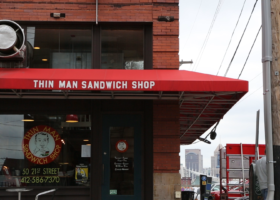The above video is an excerpt from Food Systems, Chapter 3: The Ecosystem by David Bernabo.
![]()
In the ’70s and ’80s, distribution networks for local farmers were in flux. The consolidation of ever-larger grocery chains meant that stores were swapping out direct purchases from local farmers for a new model of store-owned aggregation and warehousing. These new warehouses took advantage of economies of scale, driving down food prices for growers, and with more convenient grocery stores popping up around the city and its suburbs, the Pittsburgh public’s reliance on Strip District vendors decreased, in turn narrowing a market that the region’s farmers relied upon.
Fed up with diminishing opportunities for their food and looking to build their own distribution networks, six regional farmers came together in 1999 to form a cooperative—the Penn’s Corner Farm Alliance—focused on securing fair revenue streams. Concurrently, a restaurant renaissance was slowly emerging in Pittsburgh, as the West Cost influence of Alice Waters took root in the growing big Burrito empire. Big Burrito, which had its humble beginnings in a dark and noisy restaurant called Mad Mex in Oakland, quickly grew with a number of successively more upscale restaurants, each bearing a good bit of influence from now Corporate Chef Bill Fuller.
Together, Penn’s Corner and big Burrito established a solid path for locally-grown vegetables and locally-raised meats to travel to a diner’s dinner plate. Today, the Penn’s Corner operation is much bigger, serving a large number of Pittsburgh restaurants and offering a CSA, a farm stand program, and preserved foods.
In the above video, see Bill Fuller, founding farmers Pam Bryan and Allen Matthews, and Penn’s Corner Farm Alliance General Manager Neil Stauffer recount the early struggles of founding Penn’s Corners. Keith Reimick, Penn Corner’s Operations Manager (and an excellent filmmaker), also makes an appearance.




